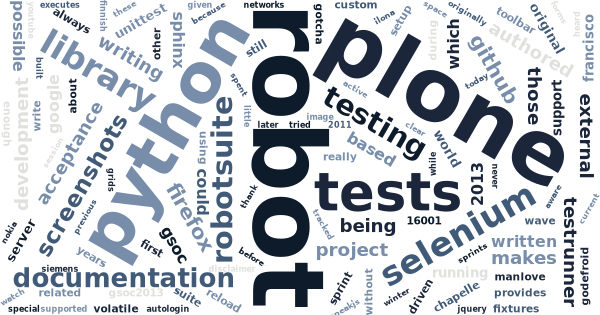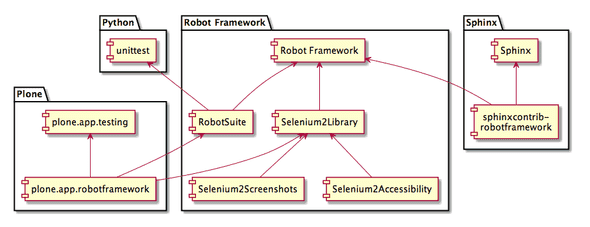Meet the Robot family (for Plone developers)
I only need to go two years back in time, and I had never really tried Selenium nor heard about Robot Framework before. Then I attended my first Plone Conference in San Francisco in 2011.
Originally, I was planning to sprint on Deco in San Francisco conference sprints, because I had spent the previous winter in developing a tile based in-house e-Portfolio management app (in Finnish) for my employer. Little did I know. I didn’t get my employer’s disclaimer for Plone contributor agreement in time, could not really get involved in the Deco-sprint, and ended up being completely side-tracked into the world of acceptance testing.
I can thank Ed Manlove for teaching me how to setup and run Selenium during the San Francisco conference. I also attended Godefroid Chapelle’s session about how we could make Selenium testing easy with Robot Framework and its Selenium RC -library. Back then, writing and running robot tests for Plone was not as convenient as it is today, but it was still inspiring enough to get us where we are now.
During the last two years we have written and contributed to many robot related packages. Now, it’s more than time to summarize, what all these robot packages are and what they can do for us:
Robot Framework (core)
Robot Framework is a well documented standalone generic test automation framework for acceptance testing and acceptance test-driven development. It’s written in Python and has no other dependencies. It has active core development team, and development of the core framework is supported by Nokia Siemens Networks.
To make it clear: Robot Framework has no ties to Plone. Also, it can be used completely without Selenium (as most of its users have always done).
The first Plone-related contribution to Robot Framework that I’m aware of, is Plone Foundation’s GSOC 2013 project to update Robot Framework’s ReST parser to support so called space separated Robot Framework test syntax, (that’s our favourite robot syntax). This should be included in Robot Framework 2.8.2 and later.
RobotSuite
RobotSuite, authored by me, provides helpers for wrapping any Robot
Framework test suite into robotsuite.RobotTestSuite{.docutils
.literal}, which makes any robot test suite compatible with Python
standard unittest-library’s unittest.TestSuite.
RobotSuite makes it possible to run Robot Framework tests using unittest-compatible test runners, like zope.testrunner.
robotframework-selenium2library
Selenium2Library is a web testing library for Robot Framework that leverages the Selenium 2 (WebDriver) libraries. It’s a rewrite of the original Selenium RC -library. Ed Manlove, a member of our Plone community, is one of its current maintainers.
While Robot Framework and Selenium2Library are enough to run robot browser tests for Plone, RobotSuite makes it possible to run the tests with zope.testrunner. And that makes it possible to run tests properly against volatile plone.app.testing-sandboxed Plone, with our custom test fixtures, so that each test is run in isolation.
plone.app.robotframework
plone.app.robotframework, authored by me and a lot of contributors from Godefroid Chapelle’s original work for plone.act, is our dedicated robot testing integration library for Plone. It is not required to test Plone with robot, but it provides conventions and a lot of convenient helpers, including:
- variables for writing test suites, which support Selenium grids
- variables and keywords for writing SauceLabs-compatible test suites
- remote keyword framework for writing fast test setup keywords in Python
- autologin remote library to skip login forms in Selenium tests
- Zope2Server-library for writing and running robot tests based on plone.app.testing{.reference .external}-fixtures with just pure Robot Framework, completely without robotsuite{.reference .external} and zope.testrunner{.reference .external}
robot-server-script for running volatile Plone-server with given plone.app.testing{.reference .external}-fixture- code-reloading
robot-serverto support test fixture driven development in sauna.reload{.reference .external}-style - optional SpeakJS-integration, which can make your Plone talk in screencasts
- shared Plone-keyword library for robot (still in development).
robotframework-selenium2screenshots
Selenium2Screenshots, authored by me, is a Robot Framework keyword library for annotating and cropping capturing screenshots with Selenium2Library and jQuery.
It’s a fun tool for creating screencasts with robot or screenshots for documentation purposes. The package has no dependencies on Plone so it can be used also with other projects.
robotframework-selenium2accessibility
Selenium2Accessibility, authored by me (from Paul Roeland’s idea), is a highly experimental Robot Framework library for automating accessibility regression tests using Selenium. It bundles a special Firefox-profile with WebAim’s WAVE Toolbar Firefox extension, WCAG Contrast checker Firefox extension and a custom Firefox extension to provide JavaScript-bridge between robot and those Firefox extensions.
It is not proven yet, but the library may help preventing new accessibility issues being introduced.
sphinxcontrib-robotframework
Finally, Robot Framework -integration for Sphinx, authored with a GSOC 2013 -project, executes embedded Robot Framework tests when Sphinx-based documentation is being built. This makes it possible to embed such Robot Framework tests into documentation that just building the documentation would generate all the screenshots that the documentation needs. For an example, see http://elvenmagic.pandala.org/ and its source.
Of course, it’s time consuming to write tests just for generating screenshots. But once those tests have been written, they can keep the screenshots always up-to-date. And if the tests are written well, those tests can be used to generate screenshots for different languages (or maybe even for different themes) for free.
The most difficult part in acceptance testing, in general, is to decide what to test. And that’s even more important for Selenium tests, which are slow to write and slow to run.
The original idea for robot tests for Plone was to test all the JavaScript-based features. Now, when those are already being testes with unit tests (with speed and in more detail) in the mockup-project. This Sphinx-integration for robot tests, could give us the new answer:
If a feature is documented in user documentation, it should be tested with acceptance test. And now those test could be embedded in the same documentation, and they would pay for themselves by creating screenshots for the documentation.
I’m quite exited of this robot family we have created together.
P.S. Yes, I’m sorry for not being able to attend the Plone Conference this year.

